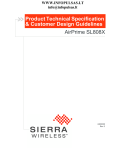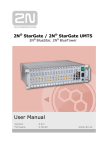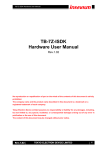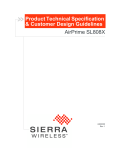Download AirPrime MC Series Dev Kit Quick Start Guide
Transcript
AirPrime MC Series Dev Kit Quick Start Guide 2130705 Rev 1.5 Preface Important Notice Due to the nature of wireless communications, transmission and reception of data can never be guaranteed. Data may be delayed, corrupted (i.e., have errors) or be totally lost. Although significant delays or losses of data are rare when wireless devices such as the Sierra Wireless modem are used in a normal manner with a well-constructed network, the Sierra Wireless modem should not be used in situations where failure to transmit or receive data could result in damage of any kind to the user or any other party, including but not limited to personal injury, death, or loss of property. Sierra Wireless accepts no responsibility for damages of any kind resulting from delays or errors in data transmitted or received using the Sierra Wireless modem, or for failure of the Sierra Wireless modem to transmit or receive such data. Safety and Hazards Do not operate the Sierra Wireless modem in areas where blasting is in progress, where explosive atmospheres may be present, near medical equipment, near life support equipment, or any equipment which may be susceptible to any form of radio interference. In such areas, the Sierra Wireless modem MUST BE POWERED OFF. The Sierra Wireless modem can transmit signals that could interfere with this equipment. Do not operate the Sierra Wireless modem in any aircraft, whether the aircraft is on the ground or in flight. In aircraft, the Sierra Wireless modem MUST BE POWERED OFF. When operating, the Sierra Wireless modem can transmit signals that could interfere with various onboard systems. Note: Some airlines may permit the use of cellular phones while the aircraft is on the ground and the door is open. Sierra Wireless modems may be used at this time. The driver or operator of any vehicle should not operate the Sierra Wireless modem while in control of a vehicle. Doing so will detract from the driver or operator's control and operation of that vehicle. In some states and provinces, operating such communications devices while in control of a vehicle is an offence. Limitation of Liability The information in this manual is subject to change without notice and does not represent a commitment on the part of Sierra Wireless. SIERRA WIRELESS AND ITS AFFILIATES SPECIFICALLY DISCLAIM LIABILITY FOR ANY AND ALL DIRECT, INDIRECT, SPECIAL, GENERAL, INCIDENTAL, CONSEQUENTIAL, PUNITIVE OR EXEMPLARY DAMAGES INCLUDING, BUT NOT LIMITED TO, LOSS OF PROFITS OR REVENUE OR ANTICIPATED PROFITS OR REVENUE ARISING OUT OF THE USE OR INABILITY TO USE ANY SIERRA WIRELESS PRODUCT, EVEN IF SIERRA WIRELESS AND/OR ITS AFFILIATES HAS BEEN ADVISED OF THE POSSIBILITY OF SUCH DAMAGES OR THEY ARE FORESEEABLE OR FOR CLAIMS BY ANY THIRD PARTY. Notwithstanding the foregoing, in no event shall Sierra Wireless and/or its affiliates aggregate liability arising under or in connection with the Sierra Wireless product, regardless of the number of events, occurrences, or claims giving rise to liability, be in excess of the price paid by the purchaser for the Sierra Wireless product. Rev 1.5 Apr.10 Proprietary and Confidential 3 AirPrime MC Series Dev Kit Quick Start Guide Patents Portions of this product may be covered by some or all of the following US patents: 5,515,013 5,929,815 6,400,336 6,785,830 6,968,171 7,200,512 D560,911 5,629,960 6,169,884 6,516,204 6,845,249 6,985,757 7,295,171 5,845,216 6,191,741 6,561,851 6,847,830 7,023,878 7, 287,162 5,847,553 6,199,168 6,643,501 6,876,697 7,053,843 D442,170 5,878,234 6,339,405 6,653,979 6,879,585 7,106,569 D459,303 5,890,057 6,359,591 6,697,030 6,886,049 7,145,267 D599,256 and other patents pending. This product includes technology licensed from QUALCOMM® 3G. Manufactured or sold by Sierra Wireless or its licensees under one or more patents licensed from InterDigital Group. Copyright ©2010 Sierra Wireless. All rights reserved. Trademarks AirCard® and Watcher® are registered trademarks of Sierra Wireless. Sierra Wireless™, AirPrime™, AirLink™, AirVantage™ and the Sierra Wireless logo are trademarks of Sierra Wireless. Windows® and Windows Vista® are registered trademarks of Microsoft Corporation. Macintosh and Mac OS are registered trademarks of Apple Inc., registered in the U.S. and other countries. QUALCOMM® is a registered trademark of QUALCOMM Incorporated. Used under license. Other trademarks are the property of their respective owners. Contact Information Sales Desk: Phone: 1-604-232-1488 Hours: 8:00 AM to 5:00 PM Pacific Time E-mail: [email protected] Post: Sierra Wireless 13811 Wireless Way Richmond, BC Canada V6V 3A4 Fax: 1-604-231-1109 Web: www.sierrawireless.com Consult our website for up-to-date product descriptions, documentation, application notes, firmware upgrades, troubleshooting tips, and press releases: www.sierrawireless.com 4 Proprietary and Confidential 2130705 Preface Revision History Revision number Release date Changes 1.2 Feb 2009 Newest UDK board; revised software installation procedure 1.3 Mar 2009 Added MC5728V. Added a column for MC5727V to Table 2-6 on page 22. Removed references to MC5720, MC5725/MC5725V. Removed QUALCOMM patents from preface. 1.4 Jul 2009 Added MC8700. Removed references to MC8755, MC8755V, MC8765V, MC8785V. Updated Table 2-6, Dev Kit—Module signal map, on page 22 1.5 Apr 2010 Added MC8201 and MC8795V. New template/branding. Rev 1.5 Apr.10 Proprietary and Confidential 5 AirPrime MC Series Dev Kit Quick Start Guide 6 Proprietary and Confidential 2130705 Contents Introduction . . . . . . . . . . . . . . . . . . . . . . . . . . . . . . . . . . . . . . . . . . . . . . . . . . . . .9 Required equipment . . . . . . . . . . . . . . . . . . . . . . . . . . . . . . . . . . . . . . . . . . . 10 Setup and Installation . . . . . . . . . . . . . . . . . . . . . . . . . . . . . . . . . . . . . . . . . . . 13 Hardware setup . . . . . . . . . . . . . . . . . . . . . . . . . . . . . . . . . . . . . . . . . . . . . . 13 Insert a SIM card (UMTS Mini Cards only) . . . . . . . . . . . . . . . . . . . . . . . 13 Insert the Mini Card . . . . . . . . . . . . . . . . . . . . . . . . . . . . . . . . . . . . . . . . . 15 Connect the antenna(s) . . . . . . . . . . . . . . . . . . . . . . . . . . . . . . . . . . . . . . 16 Connect the power supply and USB cable . . . . . . . . . . . . . . . . . . . . . . . 17 Remove/replace the Mini Card . . . . . . . . . . . . . . . . . . . . . . . . . . . . . . . . 17 Connect the Dev Kit and host device using a Mini Card Host Extender . 17 Configure the Mini Card . . . . . . . . . . . . . . . . . . . . . . . . . . . . . . . . . . . . . . . . 18 Install / update Mini Card drivers and Watcher . . . . . . . . . . . . . . . . . . . . . . 22 Download CDMA installer package . . . . . . . . . . . . . . . . . . . . . . . . . . . . . 22 Download UMTS installer package . . . . . . . . . . . . . . . . . . . . . . . . . . . . . 23 Install CDMA or UMTS software . . . . . . . . . . . . . . . . . . . . . . . . . . . . . . .23 Schematic diagram . . . . . . . . . . . . . . . . . . . . . . . . . . . . . . . . . . . . . . . . . . . . . . 25 Bill of Materials . . . . . . . . . . . . . . . . . . . . . . . . . . . . . . . . . . . . . . . . . . . . . . . . 27 Rev 1.5 Apr.10 Proprietary and Confidential 7 AirPrime MC Series Dev Kit Quick Start Guide 8 Proprietary and Confidential 2130705 1 1: Introduction This quick start guide explains how to set up the hardware and software components of Sierra Wireless’ PCI Express Mini Card Dev Kit for use with the modules listed in Table 1-1. Table 1-1: Supported AirPrime Mini Cards a Network Mini Cards CDMA (MC57xx) MC5727 MC5727V MC5728V UMTS (MC8xxx) MC8201 MC8700 MC8775 MC8775V MC8780 MC8781 MC8790 MC8790V MC8791V MC8792V MC8795V a. Throughout this document, MC57xx and MC8xxx refer to the listed suites of CDMA and UMTS Mini Cards respectively. The Dev Kit will also be used for forthcoming CDMA and UMTS Mini Card modules. (Older Mini Cards may also be supported.) Rev 1.5 Apr.10 Proprietary and Confidential 9 AirPrime MC Series Dev Kit Quick Start Guide Required equipment Table 1-2 details the items required to begin using the Dev Kit in your development environment. If any items are missing from the Dev Kit, contact your Sierra Wireless representative. Table 1-2: Required equipment Item Included in Dev Kit Details Drivers & Watcher software No Watcher software and Mini Card device drivers for the following operatirng systems may be downloaded from www.sierrawireless.com/minicard: • Windows XP Pro (SP3) and higher • Windows Vista (SP1) and higher Registration is required to download these and other files. 10 Mini Card No The Dev Kit supports the Mini Cards listed in Table 1-1 on page 9 (purchased separately). Antenna kit Yes The antenna kit includes 2 each of: • Antenna Audio headset Yes Antenna connector removal tool Yes PCI Express Mini Card Dev Kit Yes • Antenna connector • Sample / replacement Molex connector • Connecting wire The Mini Card is inserted into the Dev Kit for testing and development. Proprietary and Confidential 2130705 Introduction Table 1-2: Required equipment (Continued) Rev 1.5 Apr.10 Item Included in Dev Kit Details Power supply Yes Universal power supply, suitable for both 120 V and 240 V UART cable Yes D-sub9 (male) to D-sub9 (female) USB cable Yes Standard USB-A to USB-B cable SIM/USIM card No (UMTS only) You need to supply a SIM/USIM with an active account for use with UMTS Mini Cards. Flat flex cable Yes Together, these are used to connect a Mini Card to a laptop via the Dev Kit. Mini Card host extender Yes Proprietary and Confidential 11 AirPrime MC Series Dev Kit Quick Start Guide 12 Proprietary and Confidential 2130705 2 2: Setup and Installation To begin using the Dev Kit with your development system, set up your hardware and software: • Hardware setup · Insert a SIM card (UMTS Mini Cards only) on page 13 · Insert the Mini Card on page 15 · Connect the antenna(s) on page 16 · Connect the power supply and USB cable on page 17 · Connect the Dev Kit and host device using a Mini Card Host Extender on page 17 • Software setup (CDMA) · Install / update Mini Card drivers and Watcher on page 22 Hardware setup Insert a SIM card (UMTS Mini Cards only) Note: Throughout this document, ‘SIM’ refers to ‘SIM’ and ‘USIM’. To use a UMTS Mini Card (MC8xxx), you need to install: • A live SIM card (with an active account), or • A test SIM card for use with a call box (for example, an Agilent 8960 or Rohde&Schwarz CMU200) To install the SIM card: 1. Place the Dev Kit face-up (as shown)—the SIM slot is on the left side beside the USB plug and the black banana plug. Figure 2-1: SIM slot location Rev 1.5 Apr.10 Proprietary and Confidential 13 AirPrime MC Series Dev Kit Quick Start Guide 2. Open the SIM casing—push the SIM slot cover into the ‘OPEN’ position (in the direction of the ANALOG HEADER), and then lift it. Figure 2-2: Opening the SIM cover 3. Insert the SIM card into the cover with its circuitry face-down—note the location of the notched corner of the card in the following image. Figure 2-3: Inserting a SIM into the open cover 4. Lower the SIM slot cover—the cover (with the card inside) will be slightly raised (not making contact with the board). 5. Gently press down on the cover and then slide the slot cover under the connector base latches into the ‘CLOSED’ position—the cover locks into place. Figure 2-4: SIM inserted with cover closed 14 Proprietary and Confidential 2130705 Setup and Installation Insert the Mini Card After inserting the SIM card, insert the Mini Card: 1. Place the Dev Kit face-up (as shown)—the Mini Card slot is in the top right corner. Figure 2-5: Mini Card slot 2. Hold the Mini Card at the screw holes and slide it into the Dev Kit’s Mini Card slot at a 45 angle (inserting it ‘flat’ may damage the module’s contacts and wear out the host connector). Figure 2-6: Inserting a Mini Card 3. Push the free end of the Mini Card down until it clicks into the black MINIPCIE latch. Figure 2-7: Locking a Mini Card into the Dev Kit Rev 1.5 Apr.10 Proprietary and Confidential 15 AirPrime MC Series Dev Kit Quick Start Guide Connect the antenna(s) After installing the Mini Card, connect the supplied antenna(s) to the Dev Kit (some Mini Cards include both a main and an auxiliary (diversity/gps) antenna): 1. Place the Dev Kit face-up. The antenna connectors are on the right side near the top. 2. Screw the silver adapter onto the Dev Kit’s main antenna connector. Figure 2-8: Connecting the antenna adapter 3. Connect the Mini Card’s main antenna to the Dev Kit’s main antenna connector using the gray wire provided—press down lightly on the connector ends. (The first few times you use these connectors, they may be quite snug—press straight down on the end to get a secure connection.) Figure 2-9: Connecting the antenna wire 4. Connect the antenna to the adapter. (The first few times you attach the antenna, it may be quite snug.) Figure 2-10: Connecting the antenna 5. If your Mini Card supports a second antenna (diversity or gps), repeat Step 2–Step 4 for the second antenna. 16 Proprietary and Confidential 2130705 Setup and Installation Connect the power supply and USB cable To install the power supply and USB cable: 1. Place the Dev Kit face-up. 2. Insert one end of the USB cable into the USB connector (beside the SIM slot)—you will connect the other end to your development computer later (DO NOT connect it yet). 3. Insert the power supply into the Dev Kit’s power supply connector (below the red banana plug, to the left of the UART1 connector)—the other end connects to a standard power outlet. Remove/replace the Mini Card When you want to remove or replace the Mini Card: 1. Place the Dev Kit face-up. 2. Remove the connecting wire(s) from the Mini Card’s antenna(s)—use the connector tool, hook it under the RF connector and pull straight up. Figure 2-11: Removing the antenna wire 3. Holding the Dev Kit firmly in place, pull both arms of the MINIPCI-E latch at the same time toward the antenna connectors to release the module. 4. Pull the Mini Card out of the slot at a 45 angle. Connect the Dev Kit and host device using a Mini Card Host Extender To test the Mini Card integrated with the host device, use the Mini Card Host Extender and flat flex cable to connect the Dev Kit board and the host device: 1. Prepare the Dev Kit as normal—insert the SIM (for UMTS modems), insert the Mini Card, and attach the antenna. (You can do these steps at any time in this procedure.) 2. Insert the Mini Card Host Extender in your host device in the same way that you would insert the actual Mini Card. Note: For simplicity, the images in this example show the Mini Card Host Extender unattached. Rev 1.5 Apr.10 Proprietary and Confidential 17 AirPrime MC Series Dev Kit Quick Start Guide 3. Insert one end of the flat flex cable (pins facing up) into any of the three connectors on the Mini Card Host Extender: a. Push the cable forward, between the tabs of the brown clip on the connector. As you move the cable forward, you will feel some slight resistance as it moves into the connector and the clip tilts slightly upward. Figure 2-12: Attaching a host extender to a Mini Card b. When the cable is seated firmly in the connector, push down on the arms of the brown clip to lock the connector in place. 4. Insert the other end of the flat flex cable into connector CN9 on the Dev Kit board using the same method. Figure 2-13: Attaching a host extender to the Dev Kit To disconnect the flat flex cable from the Mini Card Host Extender or Dev Kit board: 1. Pull up on both arms of the brown clip on the connector at the same time to release the cable. 2. Pull the flat flex cable straight out of the connector. Configure the Mini Card The Dev Kit includes several switches and jumpers that you can use to configure the Mini Card’s operation, as detailed in Table 2-1 on page 19 through Table 2-5 on page 21, and Figure 2-15 on page 21. For a detailed schematic of the kit, see Schematic diagram on page 25. Note: Some Dev Kit features are available for certain Mini Cards only. For example, the Audio and UART features are only available for voice-enabled Mini Cards. 18 Proprietary and Confidential 2130705 Setup and Installation USIM/RUIM card socket CN18 analog header SW3 audio control CN9 host adapter flex RESET switch Headset jack Main RF SMA connector SW1 LED/UART control USB port Mini Card connector GND banana plug port +3.3V banana plug port Diversity RF SMA connector +5V barrel jack power CN25 board power select Main UART D-sub9 VCC_3.3V adjust Secondary UART D-sub9 SW4 power control CN8 power routing options Figure 2-14: Dev kit switches and jumpers Table 2-1: CN25—Board power (+5 V) selecta Function Power supplied by USB cable (through CN1– USB port) Jump 1–2 Jump 3–4 b Jump 5–6 Yes Power supplied from Wall cube brick (through CN2–barrel jack power) Yes a. Required: Select one option only (Jump 1–2 or Jump 5–6) b. Pins 3 and 4 are not used Table 2-2: CN8—Power routing options ab Function Enable onboard LDO to supply VCC_3.3V power from USB cable or wall cube (see Table 2-1 on page 19 for details) Host Adapter Flex supplies VCC_3.3V Enable supercapacitor in circuit on VCC_3.3V node (useful for UMTS Mini Cards) Jump 1–2 Jump 3–4 2 Jump 5–6 Yes Yes Yes a. Required: Select either Jump 1–2 or Jump 3–4 b. Jump 5–6 is optional—use only as needed Rev 1.5 Apr.10 Proprietary and Confidential 19 AirPrime MC Series Dev Kit Quick Start Guide Table 2-3: SW3—Audio control a Function Dip1 Dip2 Dip3 +20 dB gain on MIC1P On Off +0 dB gain on MIC1P Off On Dip4 +20 dB gain on MIC1N On Off +0 dB gain on MIC1N Off On a. For line-level audio devices such as TTY consoles, we recommend setting 0 dB MIC gain. Table 2-4: SW1—LED / UART control Function / (Label on board) Headset detect (EN HEADSET DET) Button detect (EN BUTTON DET) Green LED (EN GRN LED) Red LED (EN RED LED) MIO LEDs (EN MIO LEDS) UART1 flow control (EN UART1 RTS/CTS) 20 Dip On / Off 1 On Enable headset detect Off (Default) Disable headset detect On Enable button detect Off (Default) Disable button detect On Enable green LED Off (Default) Disable green LED On Enable red LED Off (Default) Disable red LED On Enable MIO LEDs Enable for voice modems (High = Led ON) Off Disable MIO LEDs Disable for data modems On Enable RTS / CTS lines of UART1 (voice modules can be configured to support this function) Off Disable RTS / CTS lines of UART1 On Enable CD / DTR / DSR / RI of UART1 Off Disable CD / DTR / DSR / RI of UART1 On Enable UART1 transceiver Off Disable UART1 transceiver On Enable UART3 transceiver Off Disable UART3 transceiver 2 3 4 5 6 UART1 signals (EN UART1 RI/CD/ DTR/DSR) 7 UART1 main transceiver (EN UART1 XCVR) 8 UART3 secondary transceiver (EN UART3 XCVR) 9 Proprietary and Confidential State 2130705 Setup and Installation Table 2-4: SW1—LED / UART control (Continued) Function / (Label on board) Disable modem (DISABLE MODEM) Dip On / Off State 10 On Disable modem Assert (modem powerdown command) Off Enable modem De-assert (modem power up) Table 2-5: SW4—Power control Function VCC_3.3V Dip On / Off State 1 On (Default) Fixed regulation from USB power or wall cube power at 3.30 V Off Adjustable regulation from USB power or wall cube power at 3.30 V On Enable onboard LDO (Low Drop Out) regulation of power from USB or wall cube Off Disable onboard LDO On (Default) Supplied by modem Off Not supplied by modem On Supplied by Dev Kit Off Not supplied by Dev Kit 2 VCC_MSM26_DIG a Note: Pins 3 and 4 must NOT be ON at the same time. 3 4 a. Required for voice-enabled modems; not required for data modems. Default setting for non-voice modems is Dip3–On and Dip4–Off. Figure 2-15: Audio test headers Rev 1.5 Apr.10 Proprietary and Confidential 21 AirPrime MC Series Dev Kit Quick Start Guide Table 2-6: Dev Kit—Module signal mapa Pin b MC5727V MC5728V MC5727 MC8775 MC8780 MC8781 MC8790 MC8700 MC8201 MC8775V MC8790V MC8791V MC8792V MC8795V MIO6 GPIO32 GPIO3 NC GPIO_1 GPIO_1 GPIO_1 MIO16 GPIO84 GPIO21 NC GPIO_2 GPIO_2 GPIO_2 MIO28 GPIO85 GPIO20 NC GPIO_3 GPIO_3 GPIO_3 MIO30 GPIO27 GPIO19 NC GPIO_4 NC GPIO_4 MIO32 GPIO26 GPIO18 NC NC NC RI MIO44 GPIO31 GPIO7 NC NC GPIO_4 DCD/GPIO_4 MIO46 GPIO30 GPIO2 NC NC GPIO_5 DSR/GPIO_5 MIO48 GPIO18 GPIO15 NC NC GPIO_6 DTR/GPIO_6 a. ‘GPIO*’—Firmware-assigned signal names. b. ‘MIO’—Multi-purpose I/O. These are the physical pins on the module. Install / update Mini Card drivers and Watcher The most recent CDMA and UMTS Mini Card software installation packages (drivers, and Watcher for Windows XP Professional and Windows Vista) are available from www.sierrawireless.com/minicard (registration is required). If necessary, contact [email protected] for assistance, or to order the software on CD. Download CDMA installer package To download the CDMA Mini Card software installation package: 1. In your browser, go to www.sierrawireless.com/minicard (registration required). 2. Click the Docs & FW tab. 3. Click the EM/MC5xxx CDMA Firmware link. 4. Click the Watcher Versions link. 5. Click the most recent Watcher link. 6. When prompted, save the installer package to a local folder. 22 Proprietary and Confidential 2130705 Setup and Installation Download UMTS installer package To download the UMTS Mini Card software installation package: 1. In your browser, go to www.sierrawireless.com/minicard (registration required). 2. Click the Docs & FW tab. 3. Click the MC87xx GSM Firmware link. 4. Click the 3G Watcher and Drivers link. 5. Click the 3G Watcher Builds link. 6. Click the link for the most recent Watcher installer package (the File Type is MSI). 7. When prompted, save the installer package to a local folder. Install CDMA or UMTS software After downloading the appropriate installer package (CDMA or UMTS): 1. Run the installer package (.msi file). If the InstallShield Wizard window for Watcher appears, go to Step 2. Otherwise, if the Program Maintenance window appears, you have to remove an earlier version of Watcher before continuing: a. Select Remove and click Next. b. Click Remove. A window appears, showing the progress of the uninstall process, and then the InstallShield Wizard window appears when the uninstall is complete. c. Click Finish. d. Repeat Step 1 to install the new Watcher software. 2. The InstallShield Wizard Watcher Welcome window appears. 3. Click Install (CDMA) or Next (UMTS). The License Agreement appears. 4. Read the agreement, and then select I accept the terms in the license agreement. 5. Use the default folder (or click Change to select a different folder), and then click Next (CDMA) or Install (UMTS). A window appears, showing the progress of the installation process, and then the installation completed window appears. 6. Click Finish. Rev 1.5 Apr.10 Proprietary and Confidential 23 AirPrime MC Series Dev Kit Quick Start Guide 24 Proprietary and Confidential 2130705 A B C 1.0Vref 0.1Vref MIO16 TDO XIM_CLK RTCK XIM_RESET XIM_IO SPK1_P MIO6 SPK1_N MIC1_N MIC1_P 100K R261 R262 100K C82 FTZ5_6E 8 RF1 CN16 U.FL-R-SMT10 10K FTZ5_6E D33 0 0 R209 DNI R208 DNI 0 0 R207 DNI R206 DNI 0 R224 0 R205 DNI 9650-1113-017 CN17 7 FH12A-50S-0.5SH CN9 1K R218 Q1 NSBC144EDXV6T1 Q1 NSBC144EDXV6T1 1K R216 MIO28 RESET_N MIO32 TRST_N MIO30 USB- USB+ WWAN_LED VCC_2.6V 219-10MSTP SW1 LED_RED LED_GRN RF2 U.FL-R-SMT10 CN14 6 9650-1113-017 CN15 1uF W_DISABLE_N MIO44 1M R183 200ohms R184 200ohms MEGA_DATA MEGA_CMD MEGA_CLK B3S-1002 SW2 5 MIO16 XIM_RESET XIM_CLK MIO48 XIM_IO MIO28 RESET_N TP42 TP41 TP40 VCC_2.6V XC6204B262MR R145 R147 R146 R148 R149 R226 DNI 0 0 0 0 0 0 RTS1_XCVR CTS1_N UART1_RTS_CTS_EN 0ohms R230 0ohms R232 PUSH-BUTTON RESET BAS16XV2T1 D34 R242 MIO44 MIO46 W_DISABLE_N LED_GRN LED_RED EMBEDDED_LEDS_N UART1_RTS_CTS_EN UART1_DTR_DSR_CD_RI_EN R231 ENABLE_UART1 MIO32 0ohms ENABLE_UART3 C69 DIP1 : ON= EN HEADSET DET; OFF= DIS HEADSET DET MIO46 DIP2 : ON= EN BUTTON DET; OFF=DIS BUTTON DET DIP3-4 : ON ON SET BICOLOR WAN LED MODE DIP3-4 : OFF OFF -DIS WAN LED DIP3-4 : ON OFF -SET OPEN DRAIN WAN LED MODE (GRN) DIP3-4 : OFF ON -SETCMOS WAN LED MODE (RED) DIP5 : ON =EN MIO LEDS, OFF=DIS MIO LEDS DIP6 : ON=EN UART1 RTS/CTS; OFF=DIS UART1 RTS/CTS DIP7 : ON=EN UART1 RI/CD/DTR/DSR OFF= DIS UART1 RI/CD/DTR/DSR DIP8 : ON=EN UART1 XCVR, OFF=DIS UART1 XCVR DIP9 : ON= EN UART3 XCVR, OFF=DIS UART3 XCVR DIP10: ON= DISABLE MODEM, OFF= ENABLE MODEM 0ohms SECONDARY RF INTERFACE 0 0 R210 DNI R211 AUX_PCM_CLK AUX_PCM_DIN AUX_PCM_DOUT AUX_PCM_SYNC HS_DETECT_N HS_BUTTON_N WWAN_LED TXD1 RXD1 MIO48 RTS1_N MIO46 CTS1_N MIO44 SPK1_N MIC1P_IN SPK1_P MIC1N_IN VCC_2.6V HOST ADAPTER FLEX LMC7101AIM5 NOPB U24 22pF 0.01uF C89 C83 LMC7101AIM5 NOPB 22pF U25 0.01uF C88 R213 PRIMARY RF INTERFACE TDI AUXV1 TMS TCK W_DISABLE_N SI-583-1 10K R214 1K 33uF 33uF R212 VCC_2.6V VCC_LDO26_DIG R233 0ohms DTR RTS1_N CTS1_XCVR 0.01uF C71 0.1uF C70 VCC_2.6V TP43 0.01uF 0.1uF C57 C53 VCC_2.6V XIM_IN 4 254021MA008G100ZL CN13 SIM CONNECTOR TC74LCX125FT U21 TC74LCX125FT U17 1uF C74 C52 U20 C68 4.7uF C67 1K R165 VCC_3.3V R243 1K C73 600ohms 600ohms 600ohms 600ohms C8 4.7uF L1 L2 L3 L4 DNI MIO48 RXD1 CTS1_XCVR 3 10K TXD1 RTS1_XCVR RI1 C43 R189 10K MIO16 TP33 TESTPOINT_0100_RND MIO28 3 R126 R127 MIO44 MIO6 VCC_2.6V 1K 1K R129 R128 0 0 0 2 1uF CN27 2 APPROVALS ENGINEER: CHECKED: DRAWN: C63 CI RTS1_RS232 DTR1_RS232 TXD1_RS232 RI1_RS232 CD1_RS232 CTS1_RS232 RXD1_RS232 DSR1_RS232 DATE 02-05-2008 5747844-2 CN12 SCALE: D SIZE TITLE: APPROVED DWG. NO. 1 SHEET: 2500152 1 OF 2 SCHEMATIC DIAGRAM, MINI CARD DEV KIT FSCM NO. NONE CN11 5747844-2 SCDA6A0101 CN20 DATE 1 02-05-2008 Sierra Wireless DNI SD REVISIONS VCC_2.6V VCC_3.3V ENABLE_UART3 1uF C46 0.01uF MiniCard Dev Kit TF-F-8P-M-E1000 PROJECT: CD1 CD2 1uF C47 Micro SD MAX3238EEAI+T U12 C62 0.1uF DESCRIPTION Initial Release ENABLE_UART1 C45 1uF C44 0.1uF C64 C61 1.0 REV 0.01uF UART3 XCVR MAX3238EEAI+T U11 UART1 XCVR This document contains information which is proprietary and confidential to Sierra Wireless Inc. Disclosure to Persons other than the officers, employees, agenst or subcontractors of the company or licensee of this document without the prior written permission of Sierra Wireless Inc. is strictly prohibited. Copyright (C) 2004-2008 R125 MIO46 MIO28 TP34 TESTPOINT_0100_RND MIO16 SD_DATA SD_CLK SD_CMD R188 CN10 R260 R258 R259 D33 C85 C87 100K 1% 60.4K 1% 6.2K C84 C86 FTZ5_6E D33 0.01uF 0.01uF FTZ5_6E D33 0.01uF 0.01uF 22pF D31 SML-310MTT86 D32 SML-310LTT86 100K R244 D DNI 100K 1uF C49 R386 DIP SWITCHES C65 C42 1uF 1uF R217 C12 R186 0.1uF 1uF 10K R215 22pF 10K C66 100K C48 R227 100K R166 4 10K ON BOARD 2.6V LDO 10K R123 5 R122 10K R185 0.01uF 0 6 0 7 R121 8 R144 C D 1 A 2500152 Proprietary and Confidential SH. DWG. NO. Rev 1.5 Apr.10 HEADSET JACK 2.5MM A: Schematic diagram A Note: Table 2-6 on page 22 provides a cross-reference for signal names that differ between the various modules’ product specification documents. Figure 1-1: Dev Kit schematic diagram (page 1 of 2) 25 A C209 67910-0001 8 MIC29302WU U7 BARREL JACK LDO 292304-1 100K B CN1 USB CONN RAPC712X CN2 5V JACK WWAN_LED MIO44 MIO46 MIO48 UART3_TX R124 C USBUSB+ MIO28 MIO30 MIO32 W_DISABLE_N AUXV1 UART3_RX CMS01 D4 USB+ USB- 0.1uF XIM_IO XIM_CLK XIM_RESET MIO16 C208 CN25 10uF 10V C38 219-4MSTP SW4 CN21 TSW-102-14-T-S JMP 1-2 : USB CABLE PWR JMP 5-6 : BARREL JACK PWR 7 0 F1 1812L150 CTS1_N RTS1_N RXD1 TXD1 TRST_N RESET_N TMS TDI RTCK TDO TCK MIC1_P MIC1_N SPK1_P SPK1_N TSM-103-01-L-DV-M-TR AUX_PCM_SYNC AUX_PCM_DOUT AUX_PCM_DIN AUX_PCM_CLK 5005 C210 CN3 100K 1% TSW-102-14-T-S 0.1uF MIO6 R81 R82 VCC_5V 6 TRST_N TDI TMS TCK RTCK TDO RESET_N R203 R140 100K R202 100K 5006 TP201 5006 TP202 5 MIO30 MIO28 MIO16 MIO6 EMBEDDED_LEDS_N 1uF 430ohms 5006 TP203 5006 5006 TP204 TP205 MIO48 MIO46 MIO44 MIO32 EMBEDDED_LEDS_N 3 R175 4 U14 TC74LCX125FT U15 330ohms R174 330ohms R173 330ohms R172 330ohms R171 330ohms R170 330ohms R169 330ohms R168 330ohms R167 EMBEDDED_LEDS_N TC74LCX125FT D14 SML-310MTT86 330ohms D13 SML-310MTT86 R176 100 52745-1096 CN6 C54 0.1uF C59 D22 D21 D20 D19 0.01uF C58 0.1uF 3 SML-310MTT86 SML-310MTT86 SML-310MTT86 SML-310MTT86 SML-310MTT86 SML-310MTT86 SML-310MTT86 SML-310MTT86 C56 D18 D17 D16 D15 0.01uF MIC1N_IN MIC1P_IN Flex connector placed topside of board RESET_N TRST_N TDO TDI TMS TCK RTCK ARM9 JTAG FLEX CONN PWR LEDS JMP 1-2 : LDO SUPPLIES 3.3V JMP 3-4 : HOST ADAPTER SUPPLIES 3.3V JMP 5-6 : SUPERCAPACITOR IN CIRCUIT TESTPOINT_0080_RND TP26 DIP1: ON=EN FIXED OUTPUT MODE 3.3V, OFF=DIS FIXED OUTPUT MODE DIP2: ON= EN LDO; OFF= DIS LDO DIP3: ON= MODEM SUPPLIES 2.6VDIG, OFF= MC8750 DIP4: ON= ONBOARD LDO SUPPLY 2.6V (MC8750 ONLY), ELSE OFF R241 100K CN18 TSM-110-01-L-DV CN8 TSM-103-01-L-DV-M-TR R234 XIM_CLK XIM_IO XIM_RESET MIO32 MIO44 MIO46 MIO48 ANALOG HEADER AUX_PCM_SYNC CN7 TSM-110-01-L-DV 0ohms AUX_PCM_DOUT AUX_PCM_DIN AUX_PCM_CLK AUXV1 MIC1_P MIC1_N MIC1P_IN MIC1N_IN SPK1_P SPK1_N HS201M C211 CTS1_N RTS1_N RXD1 TXD1 MIO6 MIO16 MIO28 MIO30 100K DIGITAL HEADER 111-0703-001 111-0702-001 TP38 TP39 TSM-110-01-L-DV CN5 ARM9 JTAG HEADER 100K BANANA PLUGS W_DISABLE_N 48099-4000 DNI CN26 48099-0003 CN4 C200 MINICARD LATCHES C37 TP200 1SMA12AT3 R200 C39 2 47Kohms R220 47Kohms Fc = 3.39kHz 22pF C205 VCC_2.6V ENGINEER: CHECKED: DRAWN: 2 CI 02-05-2008 DATE MiniCard Dev Kit TC74LCX125FT U16 REVISIONS DATE 1 D SIZE SCALE: APPROVED SML-310MTT86 SML-310MTT86 MIC1_N MIC1_P DWG. NO. 1 SHEET: 2500152 2 OF 2 SCHEMATIC DIAGRAM, MINI CARD DEV KIT FSCM NO. NONE D26 D25 SML-310MTT86 SML-310MTT86 D23 D24 C80 0.1uF 0.1uF C81 Sierra Wireless 330ohms R181 C60 0.01uF 330ohms R180 C55 0.1uF 330ohms R179 SW3 219-4MSTP 330ohms R178 VCC_3.3V TITLE: U22 LMC7101AIM5 NOPB APPROVALS PROJECT: DESCRIPTION DIP1 : ON=EN MIC_P GAIN +20dB, OFF= DIS MIC_P GAIN DIP2 : ON=EN MIC_N GAIN +20dB, OFF= DIS MIC_N GAIN DIP3 : ON=EN MIC_P AMP BYPASS; OFF= DIS MIC_P AMP BYPASS DIP4 : ON=EN MIC_N AMP BYPASS; OFF= DIS MIC_N AMP BYPASS See Sheet 1 LMC7101AIM5 NOPB U23 REV SIGNAL LEDS This document contains information which is proprietary and confidential to Sierra Wireless Inc. Disclosure to Persons other than the officers, employees, agenst or subcontractors of the company or licensee of this document without the prior written permission of Sierra Wireless Inc. is strictly prohibited. Copyright (C) 2004-2008 CTS1_N RTS1_N TXD1 RXD1 EMBEDDED_LEDS_N 0.022uF C77 0.022uF R237 MIC AMP + LPF C206 0.01uF C204 AUDIO GAIN STAGE R236 R219 D 0.1uF R177 D27 10K R102 100K 60.4K 1% 10uF 10V R113 R246 100K 10uF 1Mohms 1Mohms R201 R204 C40 R238 R221 CN19 1M R235 C41 C76 MINICARD SMT CONNECTOR R253 91Kohms 91Kohms 10K 10uF 0.01uF 4 100K 10K 10uF C79 1M 5 1M 10uF 10V 6 1M 0.001uF R239 R240 7 1M 1M 1M R251 1M R247 R250 1M R248 R249 R252 R222 C207 R254 51Kohms 10K 51Kohms 10K R223 22pF C78 1M R255 C D 2 0.001uF C75 1M R256 R245 1M R257 Proprietary and Confidential A 2500152 26 SH. DWG. NO. 8 AirPrime MC Series Dev Kit Quick Start Guide Figure 1-2: Dev Kit schematic diagram (page 2 of 2) 2130705 B B: Bill of Materials Table B-1: Development kit bill of materials Description Qty Reference designators Vendors Vendor item numbers CONN,2.5MM,4WIRE AUDIO JACK,RT-ANGLE,SMT 1 CN10 SENIOR INDUSTRIES SI-583-1 CONNECTOR, ULTRA-MINIATURE, RF, 3.0X3.1mm 2 CN14,CN16 HIROSE UFL-R-SMT-1(10) IPEX 20279-001E-01 CONNECTOR, MINI PCI EXPRESS, 52PIN, 0.8MM, RIGHT ANGLE 1 CN3 MOLEX 67910-0002 ZIF, 10 PIN, 0.5MM, RIGHT ANGLE 1 CN6 MOLEX 52745-1096 CONNECTOR, 6 PIN, 2.54mm DUAL ROW 2 CN8, CN25 SAMTEC TSM-103-01-L-DV-M-TR TESTPOINT, COMPACT, THRUHOLE, RED PLASTIC 1 TP200 KEYSTONE 5005 TESTPOINT, COMPACT, THRUHOLE, BLACK PLASTIC 5 TP201, TP202, TP203, TP204, TP205 KEYSTONE 5006 HEADER, JTAG, SMT, 20 PIN 3 CN5, CN7, CN18 SAMTEC TSM-110-01-L-DV CONNECTOR, RF, EDGE MOUNT, SMA TYPE, 0.062 BOARD THICKNES 2 CN15, CN17 APPLIED ENGINEERING 9650-1113-017 CONNECTOR, 50 PIN, ZIF, 0.5MM, TOP CONTACT TYPE 1 CN9 HIROSE FH12A-50S-0.5SH(55) CONNECTOR, 4PIN, USB, THRU, RT ANGLE 1 CN1 TYCO 292304-1 CONNECTOR, 3 PIN, 2.5MM DC POWER JACK 1 CN2 SWITCH CRAFT RAPC712X CONNECTOR, LATCH, MINI PC EXPRESS 1 CN4 MOLEX 48099-0003 BINDING POST, BANANA JACK, VERTICAL, BLACK 1 TP38 JOHNSON COMPONENTS 111-0703-001 KEYSTONE 7007 JOHNSON COMPONENTS 111-0702-001 KEYSTONE 7006 Amp/Tyco 5747844-2 BINDING POST, BANANA JACK, VERTICAL, RED CONNECTOR, RECEPTACLE, DSUB, 9PIN, RIGHT ANGLE, 0.318 SERIES Rev 1.5 Apr.10 RAPC712 1 2 TP39 CN11, CN12 Proprietary and Confidential 27 AirPrime MC Series Dev Kit Quick Start Guide Table B-1: Development kit bill of materials (Continued) Description Qty Reference designators Vendors Vendor item numbers CONNECTOR, SIM, 8 PIN, HINGED, 29.20x17.40x2.3mm 1 CN13 SUYIN 254021MA008G100ZL CONNECTOR, MicroSD SOCKET, PUSH/PUSH, STANDARD, 14x16x1.88mm 1 CN27 MIT TF-F-8P-M-E1000 CAP,SUPER,3.6V, 17.5x42MM 1 C211 CAP-XX HS201K CAP-XX HS201M CAP-XX HS201C TAIYO YUDEN LMK212C106MG TAIYO YUDEN LMK212BJ106KD-T MURATA GRM21BR61A106KE 19L C42, C43, C44, C45, C46, C47, C48, C49, C68, C69, C200 MURATA GRM155R60J105KE1 9D TAIYO YUDEN JMK105BJ105KV-F CAP, CER, 10µF, 10V,20%, X5R, 0805 CAP, CER, 1µF, 10%, 6.3V, 1005, X5R 6 11 CAP, TANT., 33µF, 20%, 6.3V, 3528 2 C52, C67 KEMET T520T336M006ATE07 0 CAP,CER,4.7µF,20%,6.3V,SM,2012, X5R 2 C73, C74 TAIYO YUDEN CEJMK212BJ475MGT CAP,22pF, 50V, ±5%, C0G, 1005 4 C76, C88, C89, C205 TAIYO YUDEN UMK105CG220JV-F MURATA GRM1555C1H220JZ0 1D MURATA GRM155R71H102KA0 1D TAIYO YUDEN UMK105BJ102KV-F C57, C58, C59, C60, C63, C64, C66, C71, C75, C82, C83, C84, C85, C86, C87, C204 MURATA GRM155R71E103KA0 1D TAIYO YUDEN TMK105BJ103KV-F C77, C206 MURATA GRM155R71C223KA0 1D TAIYO YUDEN EMK105BJ223KV-F CAP, 1000pF, 50V, ±10%, X7R, 1005 CAP, 0.01µF, 25V, ±10%, X7R, 1005 2 16 CAP, 0.022µF, 16V, ±10%, X7R, 1005 2 28 C37, C38, C39, C40, C41, C79 C78, C207 Proprietary and Confidential 2130705 Bill of Materials Table B-1: Development kit bill of materials (Continued) Description Qty Reference designators Vendors Vendor item numbers CAP, 0.1µF, 10V, ±10%, X5R, 1005 13 C53, C54, C55, C56, C61, C62, C65, C70, C80, C81, C208, C209, C210 MURATA GRM155R61A104KA0 1D TAIYO YUDEN LMK105BJ104KV-F R82, R258 ROHM MCR01MZPF6042 KOA SPEER RK73H1ETTP6042F YAGEO RC0402FR-0760K4L KOA SPEER RK73B1ETTP101J YAGEO RC0402JR-07100RL ROHM MCR01MZPJ101 YAGEO RC0402JR-07200RL KOA SPEER RK73B1ETTP201J ROHM MCR01MZPJ201 R167, R168, R169, R170, R171, R172, R173, R174, R175, R178, R179, R180, R181 YAGEO RC0402JR-07330RL KOA SPEER RK73B1ETTP331J ROHM MCR01MZPJ331 R124 YAGEO RC0402JR-07430RL KOA SPEER RK73B1ETTP431J ROHM MCR01MZPJ431 R128, R129, R212, R215, R216, R217, R218 YAGEO RC0402JR-071KL KOA SPEER RK73B1ETTP102J ROHM MCR01MZPJ102 R259 VISHAY/DALE CRCW04026K20JNE D YAGEO RC0402JR-076K2L KOA SPEER RK73B1ETTP622J ROHM MCR01MZPJ622 RESISTOR, 60.4K, 1%, 1005, 1/16W, 50V, -55 +125C RES, 100, 5%, 1005, 1/16W, 50V, -55 +125C RES, 200, 5%, 1005, 1/16W, 50V, -55 +125C RES, 330, 5%, 1005, 1/16W, 50V, -55 +125C RES, 430, 5%, 1005, 1/16W, 50V, -55 +125C RES, 1.0K, 5%, 1005, 1/16W, 50V, -55 +125C RES, 6.2K, 5%, 1005, 1/16W, 50V, -55 +125C Rev 1.5 Apr.10 2 1 2 13 1 7 1 R176 R183, R184 Proprietary and Confidential 29 AirPrime MC Series Dev Kit Quick Start Guide Table B-1: Development kit bill of materials (Continued) Description Qty Reference designators Vendors Vendor item numbers RES, 10K, 5%, 1005, 1/16W, 50V, -55 +125C 14 R113, R122, R123, R185, R186, R188, R189, R204, R213, R214, R223, R227, R235, R240 KOA SPEER RK73B1ETTP103J YAGEO RC0402JR-0710KL ROHM MCR01MZPJ103 R220, R237 YAGEO RC0402JR-0747KL KOA SPEER RK73B1ETTP473J ROHM MCR01MZPJ473 YAGEO RC0402JR-0791KL KOA SPEER RK73B1ETTP913J ROHM MCR01MZPJ913 R219, R236, R242, R246, R247, R248, R249, R250, R251, R252, R253, R254, R255, R256, R257 YAGEO RC0402JR-071ML KOA SPEER RK73B1ETTP105J ROHM MCR01MZPJ105 R125, R126, R127, R140, R144, R146, R147, R149, R165, R211, R224, R230, R231, R232, R233 KOA SPEER RK73Z1ETTD YAGEO RC0402JR-070RL ROHM MCR01MZPJ000 RES, 47K, 5%, 1005, 1/16W, 50V, -55 +125C RES, 91K, 5%, 1005, 1/16W, 50V, -55 +125C RES, 1.0M, 5%, 1005, 1/16W, 50V, -55 +125C RES, 0.0 Ohm, 5%, 1005, 1/16W, 50V, -55 +125C 2 4 15 15 R221, R22, R238, R239 RES, POT, 100K, 30%, 0.05W 1 R102 PANASONIC EVN-5ESX50B15 RES, 100K, 1%, 1005, 1/16W, 50V, -55 +125C 16 R81, R166, R177, R200, R201, R202, R203, R234, R241, R243, R244, R245, R260, R261, R262, R386 YAGEO RC0402FR-07100KL ROHM MCR01MZPF1003 KOA SPEER RK73H1ETTP1003F U14, U15, U16, U17, U21 TOSHIBA TC74LCX125FT(EL) IC, BUFFER, QUAD, 5V TOLERANT, TSSOP-14 5 ON MC74LCX125DTG SEMICONDUCT OR IC,LDO,CMOS,LOW NOISE,150mA, 2.6V 30 1 U20 Proprietary and Confidential TOSHIBA TC74LCX125FT(EL) TOREX XC6204B262MR 2130705 Bill of Materials Table B-1: Development kit bill of materials (Continued) Description Qty Reference designators Vendors Vendor item numbers ICS, RS-232 TRANSCEIVER, LOWPOWER, ESD, -40/+85C 2 U11, U12 TEXAS INSTRUMENTS MAX3238EIDB MAXIM MAX3238EEAI+T IC, OP-AMP, LOW POWER, RAILTO-RAIL, SOT23-5 U22, U23, U24, U25 NATIONAL LMC7101AIM5NOPB SEMICONDUCT OR IC, LDO, 3A, ADJUSTABLE, TO-263- 1 5 U7 MICREL XSTR, DUAL, NPN, 47K OHM BIAS RESISTORS Q1 ON NSBC144EDXV6T1 SEMICONDUCT OR FERRITE BEAD, 600OHM@100MHz, 1005, MULTILAYER 4 1 4 L1, L2, L3, L4 MIC29302WU ROHM EMH2 TDK MMZ1005S601CT TDK MMZ1005S601A KOA SPEER CZB1EGTTP601P MURATA BLM15AG601SN1D TAIYO YUDEN BK1005HW601 DIO, BAS16XV2T1, SWITCHING, SOD-523 1 D34 ON BAS16XV2T1G SEMICONDUCT OR DIO, SCHOTTKY, 3A, 30V, 3.8x2.4x1.08 1 D4 TOSHIBA CMS01 LAMP,LED,SMD,1.6x0.8,3.6mcd@20 15 mA,GRN D13, D14, D15, D16, D17, D18, D19, D20, D21, D22, D23, D24, D25, D26, D31 ROHM SML-310MTT86 DIODE, ZEN,FTZ5.6, 5.6V/ 5MA,SC74A 1 D33 ROHM FTZ5.6ET148 DIODE, TVS, 12V, 400WPEAK, SMA PACKAGE 1 D27 DIODES INC SMAJ12A-13-F ON 1SMA12AT3G SEMICONDUCT OR LAMP,LED,SMD,1.6x0.8,3.6mcd@20 1 mA,RED D32 ROHM SML-310LTT86 FUSE 1.5A, PTC, SLOW-BLOW 1 F1 LITTELFUSE 1812L150 SWITCH, TACT, 4 PIN 1 SW2 OMRON B3S-1002 Rev 1.5 Apr.10 Proprietary and Confidential 31 AirPrime MC Series Dev Kit Quick Start Guide Table B-1: Development kit bill of materials (Continued) 32 Description Qty Reference designators Vendors Vendor item numbers SWITCH, DIP, 4-SPST, SEALED, MEDIUM, BLACK BODY 2 SW3, SW4 CTS 219-4MSTP SWITCH, DIP, 10-SPST, SEALED, MEDIUM, BLACK BODY 1 SW1 CTS 219-10MSTP Proprietary and Confidential 2130705


































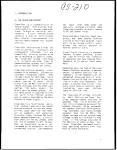
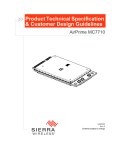
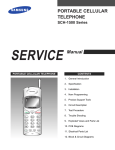

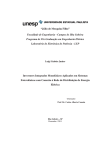
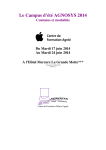

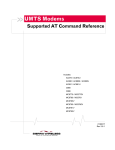
![MC95XX Series Regulatory Guide [English] (P/N 72-118502](http://vs1.manualzilla.com/store/data/005760097_1-2f741b3a88b00c5f81d3f7718b174271-150x150.png)
